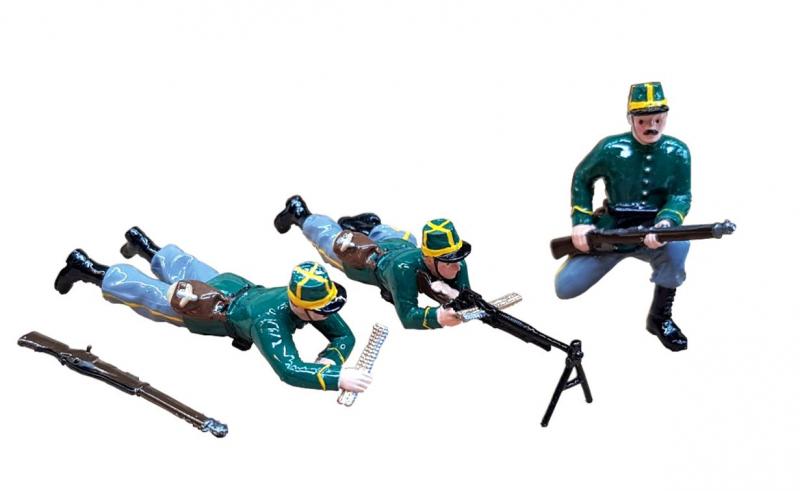WWI Belgian Army 1st Carabinier Regiment Machine Gun Set--ONE IN STOCK.
$119.99
Item Number: TRAD834
WWI Belgian Army 1st Carabinier Regiment Machine Gun Set
The Belgian Army of WWI
The evolution of mechanised warfare has been a constant quest for the perfect balance of protection, firepower and mobility. Ever subject to the laws of physics, engineers and inventors have frequently had to compromise, and prioritise the two qualities a given role demands, at the expense of the third.
While protected only by their patriotism, the cycling machine gun sections of the Belgian Carabiniers packed potent firepower into a mobile package, and were ideally suited to the war of movement in the summer of 1914. Able to deploy swiftly and stealthily along the flat roads of the Low Countries, these sections were perfect for set-piece ambushes, harassing advancing units of the German Army as they made their ill-fated push for Paris.
The Hotchkiss M1909 machine gun was used by almost all the Allied armies in WWI, chambered to various calibres to suit their national needs. Ironically, the gun was based on a design by an aristocratic Austrian Army officer, who had sold the manufacturing rights to Hotchkiss et Cie back in 1893. Refined by Laurence Benét and Henri Mercié, it is variously known as the ‘M1909 Benét-Mercié’, ‘La Hotchkissette’, and the ’Hotchkiss Portative’. The latter is the most apt, as the Hotchkiss was to find itself pressed into many mobile roles, not just with cyclist and cavalry units, but as an important armament of the British heavy tanks, that carried anywhere between three and five per machine.
This detailed Hotchkiss machine gun team is drawn directly from a series of contemporary postcards, all bearing the ‘V.P.F. Déposé’ stamp, and documenting various units of the ‘Armée Belge’ at the outbreak of WWI. Entitled: ‘Une Section de Mitrailleurs, Batallion Cycliste’, these tinted colour photographs also formed the basis of the familiar watercolour illustrations by Liliane and Fred Funcken, in their popular WWI reference book of 1974. Further research has uncovered the original un-coloured photographs, and together with the postcards, they offer some intriguing details of machine gunners preparing to take to the pedal.
The gunner took on the burden of the Hotchkiss itself, wearing a protective leather harness, like a backplate, complete with stays to keep the barrel upright on the move. His loader had a leather satchel strapped to the front of his handle bars, with two compartments holding the 30-round metal strip ammunition. A third man carried a long leather case, (similar to a sporting gun’s carrier), which presumably contained a spare barrel, tools and components. A fourth man completed the squad, armed with a rifle to cover the three gun crew while reloading or removing stoppages. Some photos in the series suggest that the Danish-designed Madsen machine gun may have been issued to some units, but only the Hotchkiss is shown ready in the firing position.
Gas-operated, and air-cooled, the M1909 was able to lay down anywhere between 400-600 round per minute, though its 12kg weight may have caused gunners to query its ’light’ designation! Adding muscle to the Mausers of the Carabinier’s firing line, this machine gun section is a must for any Great War collector.
Text: Paul Cattermole for Tradition of London, February 2020
